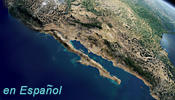![[Ocean Oasis Conservation]](images/bnr-conservation.gif)

![[Ocean Oasis Conservation]](images/bnr-conservation.gif) |  |



|
Tiburón was the first island in the Gulf of California protected by presidential decree, closely followed by Rasa. The main purpose for protecting Tiburón in 1963 was to create a mule deer refuge, protecting the species from the extensive poaching that prevailed in the Sonoran mainland (Quiñonez and Rodríguez 1979). The 1963 sanctuary was put under the management of the Secretaría de Agricultura y Recursos Hidráulicos (SARH, Ministry of Agriculture and Hydraulic Resources) an agency of the Federal Government. SARH built basic facilities for poaching control, 130 km of dirt roads, two airstrips, a small wildlife research station, and some water reservoirs to improve habitat quality for game species. The hunting habits of Seri Indians were considered a threat to the game species and an essential part of the problem of game conservation on the island. As a result, no hunting permits were granted initially to the tribe, despite the fact that Tiburón had always been part of their territory. Bighorn sheep (Ovis canadensis mexicana, the Sonoran Desert subspecies; see Monson 1980) were introduced in 1975 as a part of a federal program to study and protect bighorn in Sonora (Becerril-Nieva et al. 1988, cited in Hernández-Alvídrez and Campoy-Favela 1989). Twenty sheep (4 males) were introduced to the island, captured by staff from the New Mexico Department of Game and Fish in the mainland mountain ranges in front of the island (Montoya and Gates 1975). Before the sheep introduction, in 1967, two other species of mammals were introduced: 20 white-collared peccary (Tayassu tajacu) and 17 pronghorn antelopes (Antilocapra americana; Quiñonez and Rodríguez 1979). In 1975, however, the governmental approach changed and the interests of the Seri people were for the first time taken into account. Under the administration of Mexican President Luis Echeverría, the island was returned to Seri ownership, although it remained for some time under federal control. For two years (1975-1977) marines (the Mexican Navy had permanent presence on the island on small outposts since the 1970s) and game wardens prohibited Seri from landing on the island (Olivera and López 1988).The bighorn sheep transplant was the only successful introduction. In fact, the population grew to a number estimated in 1993 to range between 480 and 967, as evaluated through an aerial census (Lee and López-Saavedra 1994). More recent aerial surveys have estimated a population of 650 animals (Pallares 1999). In the late 1980s biologists from the Centro Ecológico de Sonora (CES, Ecological Center of Sonora, a state research center) for a couple of years continued the wildlife studies that SARH biologists initiated in the middle 1970s. Wildlife research on the island restarted with great strength in 1995 when an ambitious project to study and manage bighorn sheep took on. Scientists from the Universidad Nacional Autónoma de México (UNAM, National Autonomous University of Mexico), the Arizona Department of Game and Fish, and staff from two conservation NGOs, Unidos para la Conservación and Agrupación Sierra Madre, surveyed and studied the bighorn population. Under an innovative scheme for research and conservation funding, half of what is earned during the auctioning of the hunting permits goes to support research by UNAM's scientists and for conservation and management actions for the bighorn sheep population on Tiburón. The other half goes to the Seri tribe. In 1998 the prices paid for the permits during an auction in Reno, Nevada raised to unprecedented levels: American hunters bid up to $395,000 dollars for two permits. The 1999 auction resulted in $150,000 dollars for two more permits (Navarro 1999). The Seri community has been actively involved in this project, hiring a professional wildlife biologist for local field coordination and to train a team of young Seri men as field technicians. Seris are also bringing to the project their traditional ecological knowledge about the sheep and the island. The entire Seri community is expected to benefit from the sheep-hunting program. Money raised from hunting permits is deposited in a trust fund administered by a technical committee in which Seri participate and vote. These monies are used for health, educational and cultural projects, as well as for supporting the operational cost of the Seri traditional government. The bighorn sheep project in Tiburón also has the objective of providing animals to repopulate former bighorn sheep distribution ranges in Sonora, Chihuahua and Coahuila. Thus, Tiburón Island is now contributing in an enormous way to the conservation of bighorn sheep in mainland Mexico, and at the same time it is generating a means of income for the Seri people. This innovative management project also plans to generate resources to study other important species of the island, like the endemic mule deer, apparently suffering from habitat competition by the sheep, and the large coyote population. Under a new federal Program for Wildlife Conservation and Diversified Productive Use of Land, Tiburón island is now managed as a Unit for the Management and Sustainable Use of Wildlife (UMA, for its acronym in Spanish). Continue to Midriff Islands: Isla Rasa |
|
Text adapted from the conservation chapter of the book Island Biogeography in the Sea of Cortés, a forthcoming volume edited by Ted Case, Martin Cody, and Exequiel Ezcurra. The chapter was authored by Luis Bourillon, Antonio Cantú, Exequiel Ezcurra, María Elena Martínez, and Alejandro Robles. |
Photographs by Bradford Hollingsworth
Conservation | Site Index | Ocean Oasis
San Diego Natural History Museum & PRONATURA
© 2000 CinemaCorp of the Californias